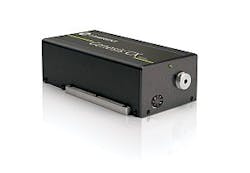UV laser from Coherent utilizes OPSL technology
Genesis CX355-250 delivers more than 250 mW of TEM00 output. All laser models utilize optically pumped semiconductor laser (OPSL) technology and provide true continuous-wave UV, rather than pulsed or quasi-CW (modelocked) output. The laser is suitable for high-throughput cytometers, confocal microscopy, and stereolithography.
Coherent Inc.
Santa Clara, CA
[email protected]
-----
PRESS RELEASE
New UV Laser Sets High Power Benchmark for CW Output
Santa Clara, Calif., March 16, 2010 – The new Genesis™ CX355 -250 laser from Coherent, Inc. (Santa Clara, CA) (Nasdaq: COHR) sets a new high-power benchmark for true-CW, ultraviolet, solid-state performance, delivering over 250 mW of TEM00 output. All Genesis CX355 lasers utilize Coherent’s unique optically pumped semiconductor laser (OPSL) technology and are the only class of commercial solid-state laser that provides true-CW UV, rather than pulsed or quasi-CW (mode-locked) output. In the Genesis CX355 -250, the inherent advantages of OPSL technology provide the ideal combination of low noise (< 0.5%) and high output power, which enables OEM instruments to achieve superior signal to noise characteristics. Moreover the Genesis CX355 -250 produces a TEM00 output beam (M² < 1.2) enabling perfect collimation and/or refocusing to a diffraction-limited spot.
The major applications that will benefit from the high power of the Genesis CX355 -250 are in flow cytometry of live-cells, such as egg and fertilized-egg sorting, where the peak power of older, mode-locked lasers poses significant risk of mutagenic damage to the DNA in the sorted cells. In addition, the high power of this new laser is ideal for use in the latest high-throughput cytometers incorporating two parallel laser interaction cells. The Genesis CX355 -250 is also an excellent source for other fluorescence-based applications, including confocal microscopy, where its short wavelength and low M² beam provide optimum excitation of Hoechst and Indo dyes. Moreover, these confocal microscopes often rely on fiber delivery which can be problematic for the high peak power levels of quasi-CW lasers. In addition, the Genesis CX355 -250 is expected to find applications in some 3D prototyping applications, i.e., stereolithography.
Founded in 1966, Coherent, Inc. is a Russell 2000 Index company and a world leader in providing laser-based solutions to the commercial and scientific research markets. Please direct any questions to Arnaud Lepert, product line manager, at (408) 764-4657, e-mail [email protected]. For more information about Coherent, including product and financial updates, visit our website at http://www.Coherent.com.
